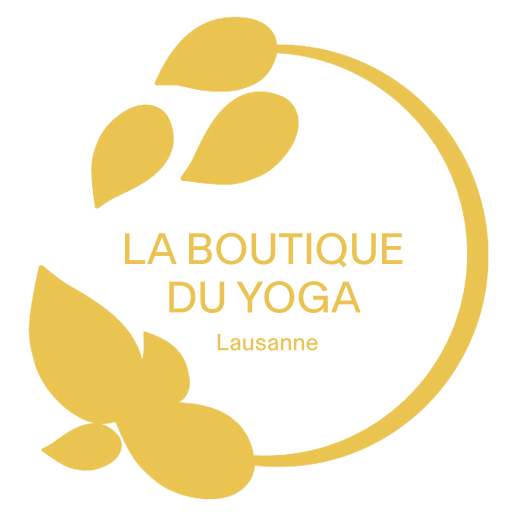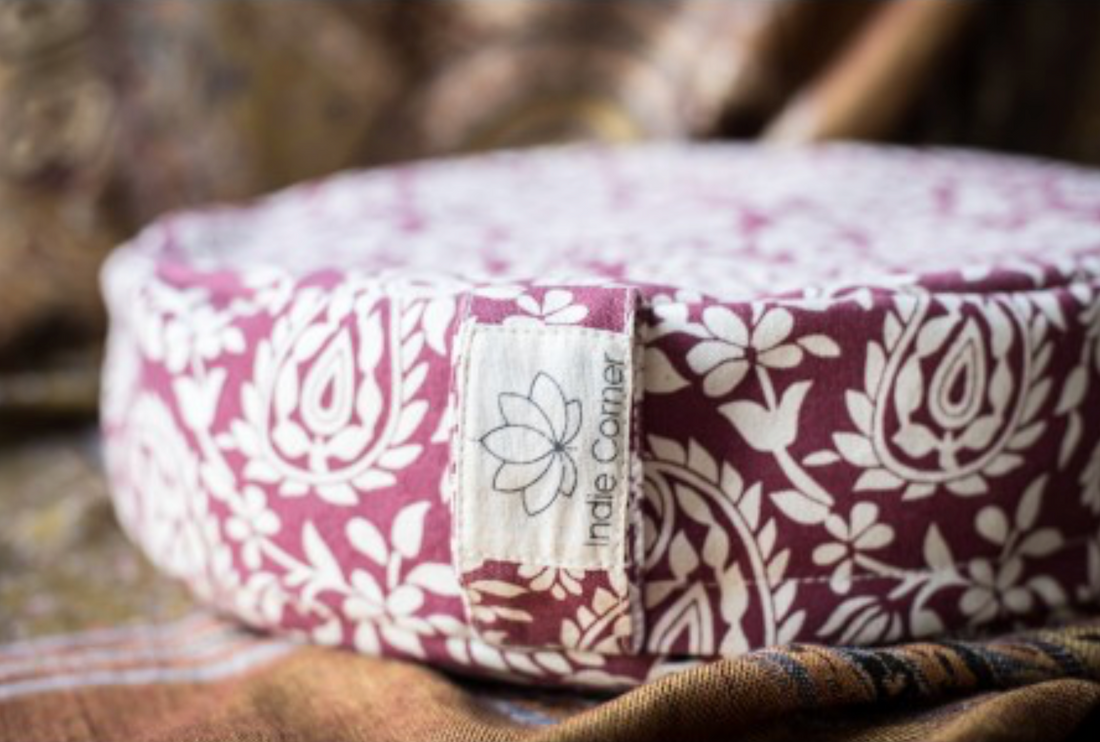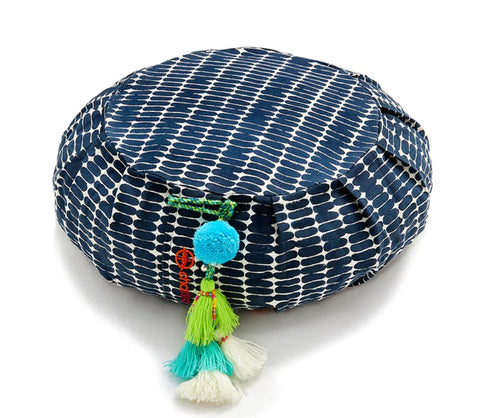In the world of yoga, there are many terminologies. And if we are not familiar with this specific vocabulary, the world of zafus, bolsters, cushions and other tools essential to our practice can seem nebulous to us. To begin, let's take a look at these various names and their function.
A zafu or meditation cushion has a rounded or half-moon shape. It is most often filled with buckwheat husks, spelled seeds or kapok (plant fiber). From an etymological point of view, “za” means “seat” and “fu” means cushion. Designed as a meditation seat, the zafu helps you maintain good lumbar alignment during your sessions by elevating your buttocks.
We call bolster Or bolster , this elongated cushion of oval or rectangular shape. It can also be filled with seeds or plant fiber. Mainly dedicated to supporting certain positions and openings in the practice of yoga, it is an essential tool for yoga soft , slow And relaxing such as Yin Yoga, Restorative Yoga or Prenatal Yoga.
THE meditation bench offers itself as an alternative at zafu . Your sitting position, however, is completely different since your knees are placed on the ground and the bench, designed in an inclined manner, supports your body by protecting your ankles and knees from your own weight. Thanks to the leaning design of the bench, your pelvis tilts forward, allowing a respected arch and vertical position. This alignment at the level of the fifth vertebra promotes concentration and meditation since your body does not suffer from an inadequate and therefore painful position.
THE zabuton is a rectangular Japanese cushion that resembles a small futon (“buton” actually means “futon” in Japanese). Very generally placed under a cushion or a meditation bench, it makes it comfortable to sit or kneel on the ground for long hours. Its function is to protect the malleolus, ankles and/or knees. Its soft and plump composition helps retain heat and makes zabuton a central tool for meditation.

Succeed in achieving good alignment is one of the major difficulties of the meditation posture. Moreover, it is not enough “only” to achieve it but also to maintain it. These two aspects can prove to be a real challenge for our body. And all the more so if we have not found the posture that is right for us. Besides, did you know that there are several types of meditation positions? Very fortunately, you might say! Indeed, it is essential, once our various bodily needs have been identified, to give them an adapted and personalized response.
The different meditation postures
Accompanied by your zafu or meditation bench, you are now ready to treat yourself to a moment of peace and relaxation. But for this, what posture should we adopt?
-
Cross-legged positions
- The lotus position
The lotus position, as its name suggests, refers to the eponymous flower. In Sanskrit, there are several ways to designate the lotus. The name “pankajam” is one of the main ones and means “that which is born in the mud”. The beautiful lotus flower emerges from the mud, from the marsh. However, it rises towards Heaven, freeing itself from the marshy and spongy waters in which it originated. Symbol of release therefore, but also and above all Renaissance and of renewal . It should also be noted that the lotus is frequently mentioned in the history of ancient Egypt and India. He is also often represented alongside Hindu or Buddhist icons such as Lakshmi (goddess of abundance), Ganesh or Buddha. Beyond its symbolic and spiritual aspect, this flagship posture of meditation also refers to the lotus because it closely resembles it. The position of the knees recalls that of the petals which grow upwards in order to rise as close as possible to the sun, to the light.
Also called “Padmasana”, the lotus posture consists of sitting with your legs crossed, right foot placed on the left thigh , left foot on right thigh . This demanding position requires a certain flexibility, which is why it is not suitable for everyone ( the use of a meditation cushion makes it possible to compensate for a lack of flexibility ). Widely used in Buddhist meditation, the lotus position helps maintain a straight back thanks to the placement of pelvis in retroversion which thus avoids being too arched. Promoting immobility, it opens the paths of concentration and appeasement .
The lotus position has many physical benefits (opening of the hips, flexibility of the joints, ligaments and muscles, less menstrual pain, etc.) and psychic (concentration, focus, deep and relaxing breathing, reduced movements, etc.). The parasympathetic nerves located in the sacrum are stimulated by the pelvis placed on the cushion, thus providing a relaxing effect. Once in the lotus position, you can place your arms on your thighs and take ten breaths in a row. Exhaled air is called “apana” . It is one of the five vital breaths (“vata”): the one which eliminates toxins, which liberates, connects the individual to matter, to anchoring. “Apana” is the energy of the Earth . Breathing that nourishes and anchors. It allows access to relaxation and elevation. The air we breathe in is called “prana”. It is the life force that goes inward . Solid, spiritual, sensory food, etc. everything we receive, everything that supports us, elevates us, sustains us is “prana”.
- The half lotus position
Very close to the lotus posture, the “half lotus” offers, for some, greater comfort. This makes it easier to focus your attention on your practice. Also called “Siddhasana”, this posture is used as much in meditation as in the practice of Hatha Yoga. This involves sitting on your zafu and positioning your left heel against the perineum while positioning the right just above, at the level of the pubis.
The Burmese posture is again a cross-legged posture with, this time, the calves and ankles resting on the ground. Traditionally, the left calf is placed in front of the right, but you can simply choose the posture that suits you best. The feet are also placed flat, the soles turned towards you and the knees must touch the ground. This posture is ideal for testing your flexibility and gradually reaching more complex positions such as the lotus position. Concerning the positioning of the hands , it is not necessary to practice the “ guyan mudra ”, a sacred gesture used by monks. You can also simply place your hands on your thighs, palms facing the sky.
- The seiza (or diamond) position
This posture can be practiced with a zafu (positioned on the edge) or using a meditation bench. It is often considered one of the most accessible meditation postures because it does not require lateral rotation of the hips. Body alignment is more easily achieved and maintained. However, it is important to choose the support that corresponds to your body shape and your flexibility in order to achieve optimal distribution of your body weight between the seat, knees and kicks. By being too low, you carry the majority of the pressure on your feet, while by being too high the influence of your body is on the menisci of the knee. Moreover, for meditators with fragile ankles and knees, the use of a zabuton is ideal here. It offers unparalleled comfort and support.
- On a chair
Meditating on a chair is a very good alternative when we don't have our meditation cushion or bench within reach. In addition, the natural inclination of the chair is very well suited to meditation. On the condition, however, that you do not lean on the backrest but stay at the edge of the seat.
And of course, let's not forget that it is possible to meditate at any time. While walking, during daily tasks, on public transportation, at work, wherever your mind can, for a few minutes, settle down , to rest , align . I hope that this article can shed light on some of your questions or, quite simply, that it will resonate with you, both in the way you practice meditation and how you think about it.
Proposal for an autumn meditative walk
Finally, in these days of flamboyant autumn colors, I offer you a moving meditation, outside, in a place that you particularly cherish and where, above all, you feel good.
Before starting your walk, take the time to connect to your breathing . Inhale (“prana”) and exhale (“apana”) slowly, paying attention to the sensations what this exercise arouses in you. Once you feel calm And present) to yourself and to the world, gently begin a walk to the rhythm of your breathing . You can inhale for two steps and exhale for two steps again. From the space of the heart , observe what comes to life around you. Activate your different senses, connect to the different sounds, smells, materials around you. In this moment of contemplation and connivance with Nature and your own Presence, take the time to clearly formulate a deep intention. You can also, at the start of your walk, grab a stone symbolizing what you would like to get rid of in the moment. At the end of your walk, place the stone in Nature. By freeing yourself from it, you also free yourself from what weighs you down and which, from now on, no longer belongs to you.



